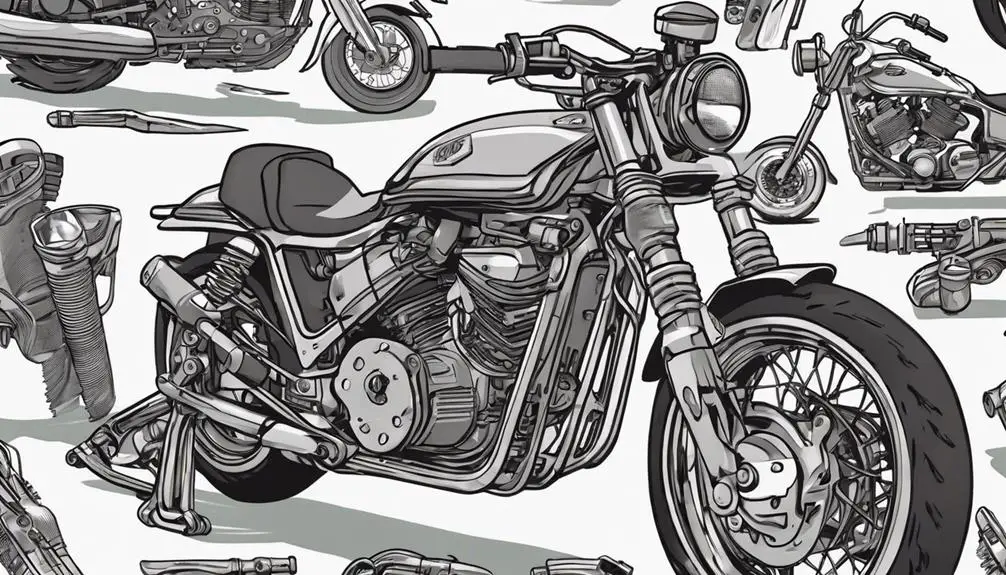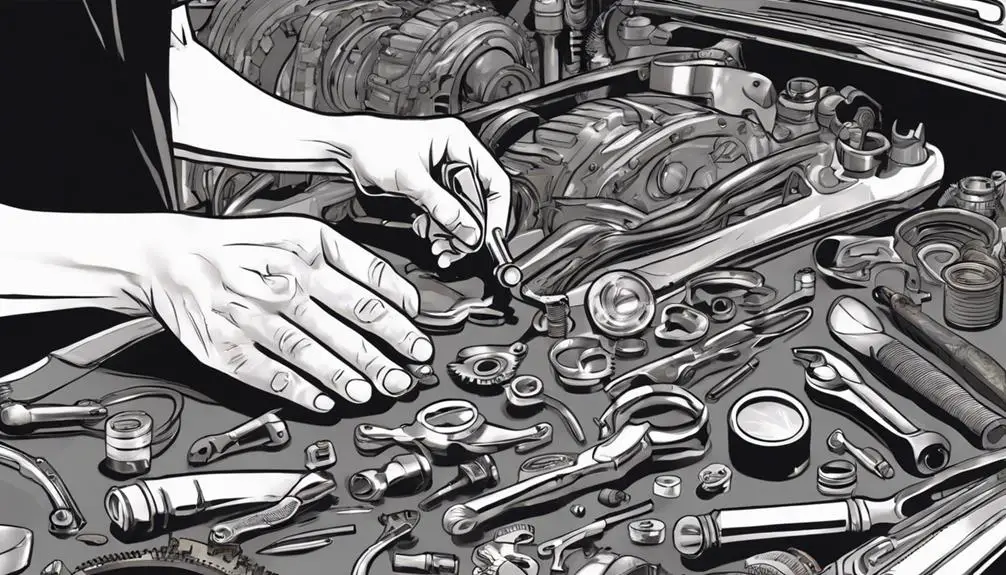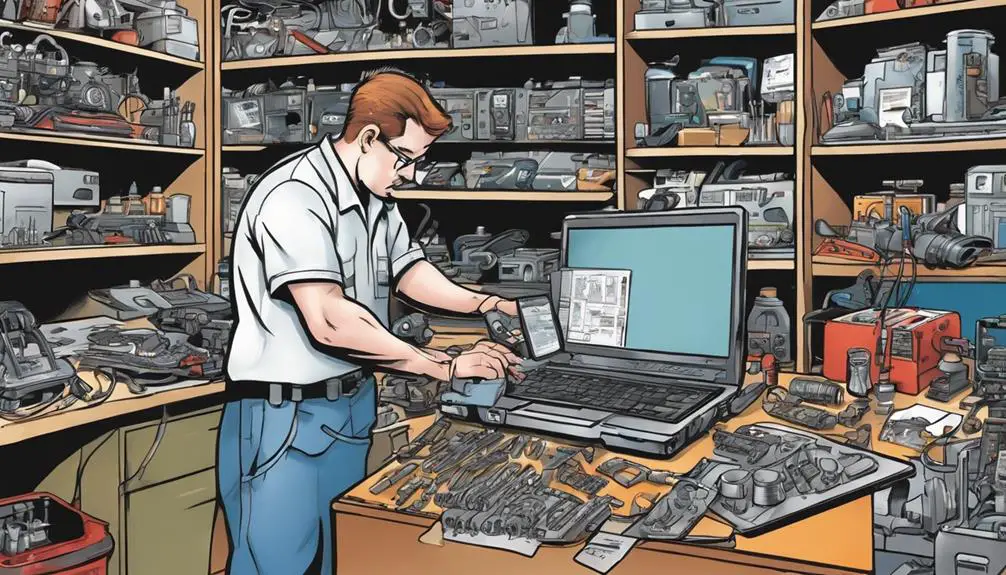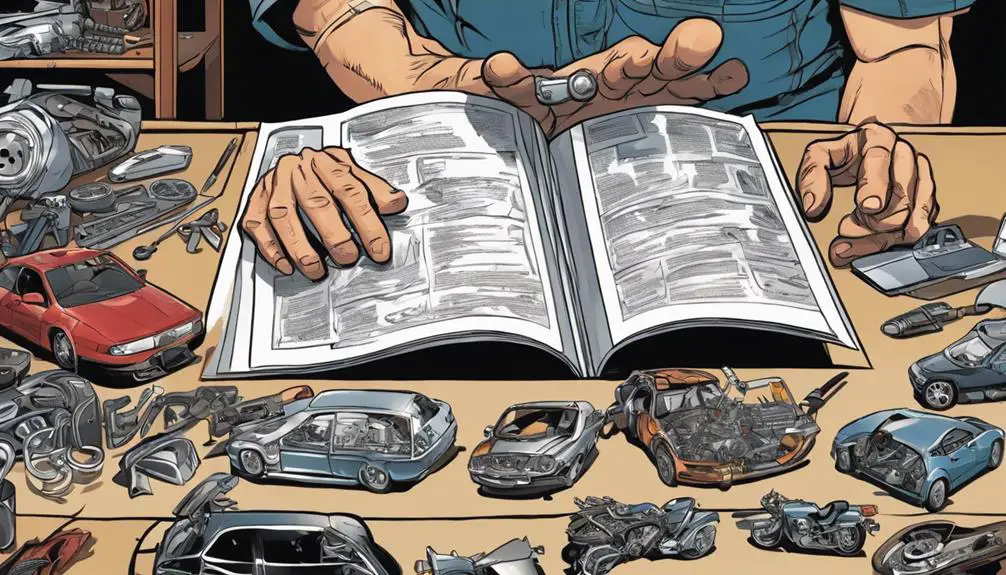When you're selecting replacement parts for your motorcycle, it's essential to start with a solid understanding of your specific model. This knowledge will guide you in evaluating quality and compatibility between OEM and aftermarket options. You'll want to research reputable suppliers and weigh the benefits of warranties, but don't overlook the importance of installation requirements. By considering these factors, you can avoid costly mistakes and enhance your bike's performance. Still, there are a few key strategies that can make this process even smoother—let's explore those next.
Quick Takeaways
- Know your motorcycle's year, make, and model to ensure accurate part selection and compatibility.
- Assess the quality of parts by evaluating materials and checking customer reviews for reliability and performance insights.
- Consider OEM parts for guaranteed compatibility or high-quality aftermarket options for cost-effective customization.
- Research multiple reputable suppliers to compare pricing, warranty options, and customer support quality before making a purchase.
Understand Your Motorcycle Model

To choose the right replacement parts, you need to know your motorcycle model inside and out. This knowledge empowers you to make informed decisions that enhance your ride and keep your machine running smoothly.
Start by digging into the specifics—check the year, make, and model. Each piece of your bike is designed for a particular configuration, and understanding these details is essential.
Dive into the owner's manual; it's your best friend. Look for diagrams that illustrate the parts and their functions. Familiarize yourself with the terminology—knowing the difference between a carburetor and a fuel injector can save you time and money.
Don't hesitate to join online forums or local motorcycle clubs. These communities can offer invaluable insights and help you connect with fellow riders who share your passion for liberation on two wheels.
Identify Common Replacement Parts
Identifying common replacement parts for your motorcycle can streamline the maintenance process and enhance your riding experience. Knowing which parts tend to wear out or need replacement helps you stay ahead of potential issues. Start with the essentials: tires, brake pads, and oil filters. These components are essential for your safety and performance on the road.
Next, consider your chain and sprockets. Regular inspection is key, as these parts endure significant stress and can affect your bike's handling. If you're into long rides, pay attention to your battery's condition, too. A reliable battery guarantees your bike starts smoothly every time, setting you free for those spontaneous journeys.
Don't forget about your air filter and spark plugs. A clean air filter boosts engine efficiency, while fresh spark plugs guarantee peak combustion. Also, it's wise to have a stock of fuses and bulbs handy. They're small but important for your bike's electrical system.
Assess Quality and Compatibility

Regularly evaluating the quality and compatibility of replacement parts guarantees your motorcycle performs at its best and keeps you safe on the road. When you're out there, living free, the last thing you want is a malfunction due to subpar components.
Start by checking the materials used in the parts. Durable materials like high-grade steel or aluminum often indicate reliability, while cheaper plastics might compromise your ride.
Next, compatibility is essential. Always refer to your motorcycle's specifications, ensuring the part fits seamlessly into your machine. A mismatch can lead to poor performance or even damage.
Don't hesitate to consult forums or communities of fellow riders; they can provide valuable insights based on their experiences.
Consider OEM Vs. Aftermarket Parts
When evaluating replacement parts, you'll often find yourself weighing the benefits of OEM (Original Equipment Manufacturer) parts against aftermarket options. This choice is vital for ensuring your vehicle performs at its best. OEM parts are designed specifically for your make and model, guaranteeing compatibility and quality. However, aftermarket parts can offer significant advantages too, often at a lower price point.
Here are some key factors to reflect on:
- Cost: Aftermarket parts usually come at a more affordable price, which can free up your budget for other upgrades.
- Variety: The aftermarket world boasts a vast selection of parts, allowing you to customize your vehicle to your liking.
- Quality: Not all aftermarket parts are created equal; some can rival or exceed OEM standards.
Ultimately, the decision between OEM and aftermarket should align with your vehicle's needs, your budget, and your personal preferences. Embrace the power of choice, and make a decision that liberates your driving experience.
Research Reputable Suppliers

When you're looking for replacement parts, it's essential to research reputable suppliers.
Start by verifying their credentials to guarantee you're getting quality products.
Then, compare pricing options to find the best deal without sacrificing reliability.
Verify Supplier Credentials
To guarantee you're getting quality replacement parts, start by thoroughly researching and verifying the credentials of potential suppliers. This step is essential in making certain that you receive parts that meet your needs and standards. Don't be swayed by flashy advertisements; focus on the facts.
Here are some key points to evaluate when verifying supplier credentials:
- Check Reviews: Look for customer testimonials and online reviews to gauge the supplier's reputation.
- Certifications: Confirm the supplier has relevant certifications that demonstrate their compliance with industry standards.
- Experience: Investigate how long the supplier has been in business. Experience often translates to reliability and expertise.
Compare Pricing Options
As you research reputable suppliers, it's crucial to compare pricing options to guarantee you're getting the best value for your replacement parts. Start by gathering quotes from multiple suppliers to understand the price range for the parts you need. This step not only helps you identify the most competitive rates but also highlights any outliers that might raise red flags.
Don't just look at the sticker price; consider shipping costs, warranty options, and return policies. Sometimes, a slightly higher price can offer better long-term value through quality assurance and customer support. You want to feel liberated in your choices, free from the burden of hidden fees or subpar products.
Also, read reviews and seek feedback from other customers. Their experiences can provide insight into whether a supplier's pricing reflects their reliability and product quality. Creating a spreadsheet or list can help you visualize your options clearly.
Ultimately, by comparing pricing options wisely, you empower yourself to make informed decisions. This way, you can take control of your purchases, ensuring you select parts that not only fit your needs but also respect your budget.
Read Customer Reviews
Regularly reading customer reviews can provide valuable insights into the quality and reliability of replacement parts. These reviews often reflect real-world experiences and can guide your purchasing decisions. When you explore customer feedback, you can uncover details you mightn't find in product descriptions or specifications.
Consider these key points when sifting through reviews:
- Quality Control: Look for mentions of durability and performance over time.
- Installation Ease: Many customers share their installation experiences, helping you gauge how user-friendly a part is.
- Customer Support: Reviews often highlight the level of assistance provided by the seller, which can be significant if you encounter issues.
Evaluate Warranty Options

When selecting replacement parts, it's essential to understand the warranty coverage that comes with them.
You should also compare the durations of different warranties to guarantee you're making a smart investment.
Knowing these details can save you time and money down the road.
Understand Warranty Coverage
Evaluating warranty options is essential for ensuring that you're protected against unexpected repair costs. When you select replacement parts, understanding the warranty coverage can give you peace of mind, allowing you to focus on what truly matters—your freedom to enjoy your life without financial worries.
Here are some key factors to reflect on:
- Coverage Scope: Know what's included and excluded in the warranty. Are labor costs covered, or just the parts?
- Claim Process: Understand how to file a claim. A hassle-free process means less time spent worrying and more time enjoying your purchase.
- Transferability: If you plan to sell the item later, check if the warranty can be transferred to the new owner. This can enhance the resale value.
Compare Warranty Durations
Comparing warranty durations can help you identify the best protection for your investment, ensuring you're covered for as long as possible. When you're choosing replacement parts, don't just settle for the first option—dig deeper into the warranties offered. A longer warranty often indicates a manufacturer's confidence in their product, which can provide you peace of mind.
Look at the specifics: Is the warranty for one year or five? Are there conditions that could void it? Some warranties cover only parts, while others include labor. Understand what you're getting into. If you're investing in a high-quality part, a longer warranty can be a game-changer, giving you the freedom to make repairs without the constant worry of unexpected costs.
Also, pay attention to the reputation of the manufacturer. A company known for excellent customer service and support can make a significant difference when you need assistance under warranty.
Ultimately, choosing a part with a robust warranty can liberate you from the stress of potential repairs, allowing you to focus on enjoying your investment. So take the time to compare warranties and choose wisely. Your future self will thank you!
Check for Installation Requirements
How can you guarantee that the replacement parts fit your specific needs without first checking their installation requirements?
It's crucial to verify that the parts you choose not only match the specifications but also integrate seamlessly into your project. By understanding the installation requirements, you can avoid frustration and wasted resources.
Here are some key factors to take into account:
- Compatibility: Verify that the replacement part is designed for your specific model or system.
- Tools Needed: Identify any special tools required for installation. You don't want to be caught off-guard mid-install.
- Skill Level: Assess whether the installation is something you can handle or if you need professional help.
Compare Prices Effectively

Finding the best price on replacement parts requires a strategic approach to confirm you're getting the best value for your money. Start by researching multiple suppliers and online marketplaces.
Don't just settle for the first option; compare prices widely. Utilize price comparison websites to streamline this process. They can save you time and make sure you're not overlooking better deals.
Next, consider the total cost, including shipping fees or any hidden charges. A lower upfront price mightn't be a bargain if the shipping costs skyrocket. Also, check for discounts or promotions that can greatly reduce your overall expenditure.
Don't forget to factor in the quality of the parts. Sometimes, a cheaper option might compromise on reliability, leading to more expenses down the line. Read reviews and ratings to gauge customer satisfaction.
Seek Professional Advice
Consulting a professional can save you time and money when selecting the right replacement parts for your needs. Experts in the field can guide you through the process, ensuring you make informed choices that enhance your equipment's performance. Instead of maneuvering through the maze of options alone, lean on their knowledge to liberate yourself from costly mistakes.
Here are a few reasons to seek professional advice:
- Expertise: They understand the nuances of parts compatibility and quality.
- Sourcing Options: Professionals often have access to exclusive suppliers, getting you better deals.
- Troubleshooting: They can identify underlying issues, preventing future problems.
Don't hesitate to reach out to specialists, whether they're mechanics, technicians, or parts retailers. Their insights are invaluable and can empower you to make the best choices.
Investing in professional advice is an investment in your freedom—freedom from worry, confusion, and unnecessary expenses. So, embrace the help available to you and take control of your replacement parts selection confidently!
Common Questions
How Can I Determine the Right Size for Replacement Parts?
To determine the right size for replacement parts, start by measuring the existing component accurately.
Use a ruler or caliper for precise dimensions, noting length, width, and thickness.
Check the manufacturer's specifications if available, as they'll guide you in selecting compatible sizes.
If you're unsure, consult experts or online forums for advice.
What Tools Do I Need for Replacing Motorcycle Parts?
Did you know that nearly 70% of motorcycle owners perform their own maintenance?
To replace motorcycle parts, you'll need a few essential tools. Grab a socket set, wrenches, screwdrivers, and pliers for most jobs. A torque wrench will guarantee you don't overtighten bolts, while a bike stand stabilizes your ride.
With these tools, you'll feel empowered to tackle repairs and keep your bike in top shape, embracing the freedom of self-sufficiency.
Are There Specific Maintenance Tips for New Replacement Parts?
When you install new replacement parts, it's crucial to give them some extra attention.
Always check the manufacturer's guidelines for specific maintenance tips.
Regularly inspect for any wear or looseness, and keep them clean to avoid build-up.
Lubricate moving parts as needed, and stay on top of any scheduled maintenance to guarantee everything runs smoothly.
Trust your instincts, and don't hesitate to address any concerns that arise during your rides.
How Often Should I Replace My Motorcycle Parts?
You should replace your motorcycle parts based on wear and performance. Generally, check components like brake pads, tires, and chains every few thousand miles or during routine maintenance.
If you notice unusual noises or handling issues, inspect those parts immediately.
Regularly evaluating your bike's condition not only enhances safety but also gives you a sense of freedom, allowing you to ride confidently without worrying about potential failures on the road.
Can I Mix OEM and Aftermarket Parts on My Motorcycle?
You can mix OEM and aftermarket parts on your motorcycle, but you should weigh the pros and cons first.
OEM parts guarantee quality and compatibility, while aftermarket parts can offer better performance or unique designs.
Consider your riding style, budget, and maintenance needs.
If you choose to combine them, make certain they work well together, enhancing your bike's performance without compromising safety.
Embrace the freedom to customize, but always prioritize functionality and reliability.
Wrapping Up
When it comes to selecting replacement parts for your motorcycle, remember that knowledge is your best ally.
By understanding your model and weighing your options, you're not just fixing a machine; you're nurturing your passion for the ride.
You'll feel the thrill of the open road, knowing you've made informed choices.
So gear up with research and expert advice, and let your motorcycle roar back to life, ready to take you on unforgettable adventures.